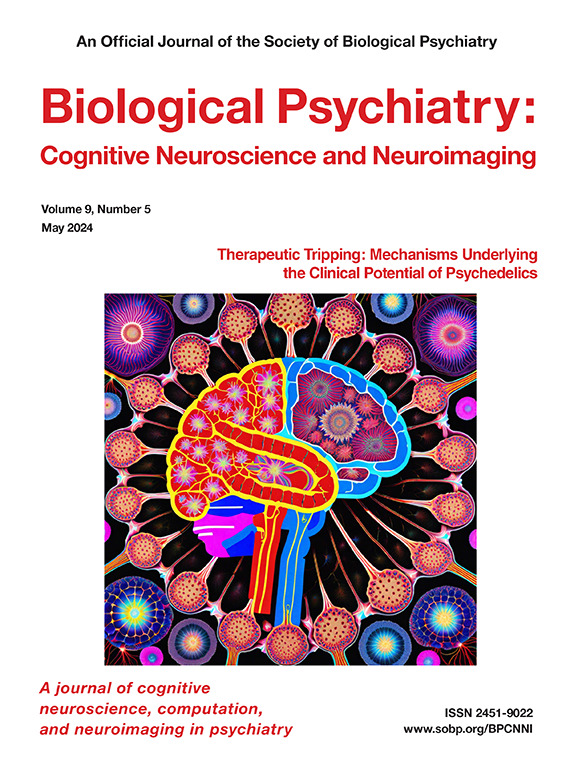Altered Neural Responses to Punishment Learning in Conduct Disorder
IF 4.8
2区 医学
Q1 NEUROSCIENCES
Biological Psychiatry-Cognitive Neuroscience and Neuroimaging
Pub Date : 2025-09-01
DOI:10.1016/j.bpsc.2025.01.003
引用次数: 0
Abstract
Background
Conduct disorder (CD) is associated with deficits in the use of punishment for reinforcement learning (RL) and subsequent decision making, contributing to reckless, antisocial, and aggressive behaviors. Here, we used functional magnetic resonance imaging (fMRI) to examine whether differences in behavioral learning rates derived from computational modeling, particularly for punishment, are reflected in aberrant neural responses in youths with CD compared with typically developing control participants (TDCs).
Methods
A total of 75 youths with CD and 99 TDCs (9–18 years, 47% girls) performed a probabilistic RL task with punishment, reward, and neutral contingencies. Using fMRI data in conjunction with computational modeling indices (learning rate α), we investigated group differences for the 3 learning conditions in whole-brain and region of interest (ROI) analyses, including the ventral striatum and insula.
Results
Whole-brain analysis revealed typical neural responses for RL in both groups. However, linear regression models for the ROI analyses revealed that only the response pattern of the (anterior) insula during punishment learning was different in participants with CD compared with TDCs.
Conclusions
Youths with CD have atypical neural responses to learning from punishment (but not from reward), specifically in the insula. This suggests a selective dysfunction of RL mechanisms in CD that contributes to punishment insensitivity/hyposensitivity as a hallmark of the disorder. Because the (anterior) insula is involved in avoidance behaviors related to negative affect or arousal, insula dysfunction in CD may contribute to inappropriate behavioral decision making, which increases the risk for reckless, antisocial, and aggressive behaviors in affected youth.
行为障碍患者对惩罚学习的神经反应改变。
目的:行为障碍(CD)与强化学习(RL)和后续决策的惩罚使用缺陷有关,导致鲁莽、反社会和攻击行为。在这里,我们使用功能性磁共振成像(fMRI)来检查计算模型产生的行为学习率的差异,特别是对惩罚的差异,是否反映在患有CD的青少年与正常发育的对照组(TDCs)的异常神经反应中。方法:75名患有CD的青少年和99名患有tdc的青少年(9-18岁,其中47%为女孩)执行一项带有惩罚、奖励和中性偶然性的概率RL任务。利用fMRI数据结合计算建模指数(学习率α),研究了三种学习条件下全脑和兴趣区(ROI)分析的组间差异,包括腹侧纹状体和脑岛。结果:全脑分析显示两组RL的典型神经反应。然而,ROI分析的线性回归模型显示,与tdc相比,CD在惩罚学习过程中只有(前)脑岛的反应模式不同。结论:患有乳糜泻的青少年对从惩罚中学习(而不是从奖励中学习)有非典型的神经反应,特别是在脑岛。这表明CD中RL机制的选择性功能障碍,从而导致了作为该疾病标志的“惩罚不敏感/低敏感性”。由于(前)脑岛参与与消极情绪或觉醒相关的回避行为,乳糜泄患者的脑岛功能障碍可能导致不适当的行为决策,从而增加患青少年鲁莽、反社会和攻击行为的风险。
本文章由计算机程序翻译,如有差异,请以英文原文为准。
求助全文
约1分钟内获得全文
求助全文
来源期刊

Biological Psychiatry-Cognitive Neuroscience and Neuroimaging
Neuroscience-Biological Psychiatry
CiteScore
10.40
自引率
1.70%
发文量
247
审稿时长
30 days
期刊介绍:
Biological Psychiatry: Cognitive Neuroscience and Neuroimaging is an official journal of the Society for Biological Psychiatry, whose purpose is to promote excellence in scientific research and education in fields that investigate the nature, causes, mechanisms, and treatments of disorders of thought, emotion, or behavior. In accord with this mission, this peer-reviewed, rapid-publication, international journal focuses on studies using the tools and constructs of cognitive neuroscience, including the full range of non-invasive neuroimaging and human extra- and intracranial physiological recording methodologies. It publishes both basic and clinical studies, including those that incorporate genetic data, pharmacological challenges, and computational modeling approaches. The journal publishes novel results of original research which represent an important new lead or significant impact on the field. Reviews and commentaries that focus on topics of current research and interest are also encouraged.
 求助内容:
求助内容: 应助结果提醒方式:
应助结果提醒方式:


